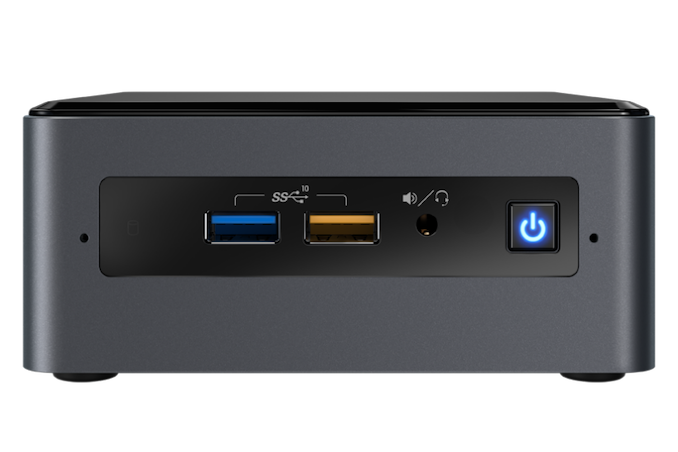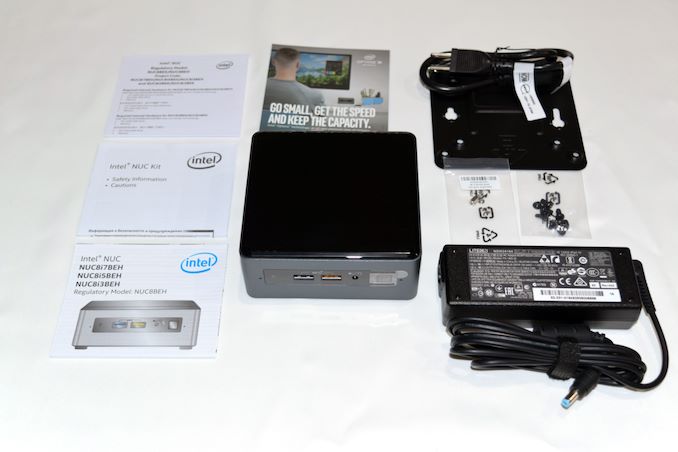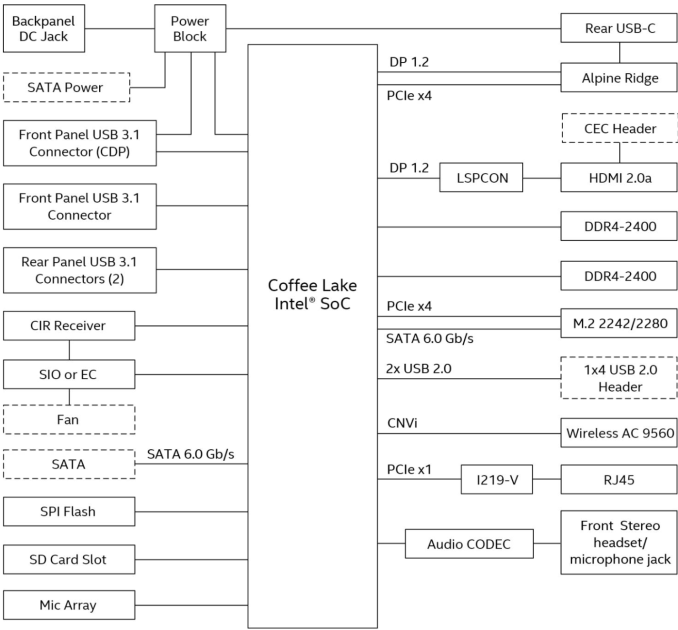Intel's Bean Canyon (NUC8i7BEH) Coffee Lake NUC Review - Ticking the Right Boxes
by Ganesh T S on April 3, 2019 8:00 AM EST- Posted in
- Systems
- Intel
- NUC
- UCFF
- Thunderbolt 3
- Cannon Point
- Coffee Lake-U

Intel's NUCs have managed to develop a strong market for ultra-compact form-factor (UCFF) machines since they were introduced in the early 2010s. Each CPU generation has seen Intel put out stronger versions of the NUC (both in terms of performance and features) in a regular cadence. In parallel, we have seen experiments with slightly larger form-factors (such as the Skull Canyon and Hades Canyon NUCs). Currently, Intel has NUC platforms targeting three different market segments - the entry-level, mid-range, and enthusiast. While the entry level is served by Atom-class SoCs and the enthusiast category by H-/G-series CPUs, the mid-range is served by the U-series SiPs (system in package) that use the Core microarchitecture. Today, we are looking at Intel's latest flagship in the mid-range segment - the Core i7-based Bean Canyon (NUC8i7BEH).
Introduction and Platform Analysis
The Intel NUC8i7BEH belongs to the Bean Canyon NUC family. It is based on the Coffee Lake-U series SiPs (CFL-U). The Bean Canyon NUCs build upon the capabilities of the Kaby Lake NUCs (NUC7 / Baby Canyon series). From an external I/O perspective, the Bean Canyon and Baby Canyon NUCs do not appear significantly different. However, the usage of a CFL-U SiP (CPU and PCH integrated in a single package) enables the following updates in the Bean Canyon family:
- 28W TDP processors across all SKUs, with true quad-core / octa-thread options
- Iris Plus Graphics 655 with 128MB eDRAM across all SKUs
- Intel Wireless-AC 9560 with Bluetooth 5.0 WLAN module
- USB 3.1 Gen 2 (10 Gbps) support on all external Type-A ports
The TDP upgrade (15W to 28W) makes it necessary for Intel to supply a 90W power adapter with the Bean Canyon NUCs (compared to the 65W ones supplied with the Baby Canyon models).
The NUC8i7BEH that we are looking at today comes with a Core i7-8559U processor. The 'H' in the model indicates a tall kit with support for the installation of a 2.5" SATA drive. The kit is available barebones, and users need to install either a SATA or a M.2 2280 / 2260 / 2242 NVMe drive and appropriate DDR4 SO-DIMMs. We utilized a Western Digital Black NVMe SSD and two G.Skill DDR4-3000 SODIMMs to complete our build.
The specifications of our Intel NUC8i7BEH (Bean Canyon) review configuration are summarized in the table below.
| Intel NUC8i7BEH (Bean Canyon) Specifications | |
| Processor | Intel Core i7-8559U Coffee Lake-U, 4C/8T, 2.7 (4.5) GHz 8MB L2, 28 W TDP |
| Memory | G.Skill RipjawsV F4-3000C16-16GRS DDR4 SODIMM 18-18-18-43 @ 3000 MHz 2x16 GB |
| Graphics | Intel Iris Plus Graphics 655 |
| Disk Drive(s) | Western Digital WD Black 3D NVMe SSD (2018) (1 TB; M.2 Type 2280 PCIe 3.0 x4 NVMe; SanDisk 64L 3D TLC) |
| Networking | Intel Dual Band Wireless-AC 9560 (2x2 802.11ac - 1733 Mbps) Intel I219V Gigabit Ethernet controller |
| Audio | 3.5mm Headphone Jack Capable of 5.1/7.1 digital output with HD audio bitstreaming (HDMI) |
| Miscellaneous I/O Ports | 1x Thunderbolt 3 Type-C 4x USB 3.1 Gen 2 Type-A 1x micro-SDXC |
| Operating System | Retail unit is barebones, but we installed Windows 10 Enterprise x64 |
| Pricing | $503 (barebones) $963 (as configured, no OS) |
| Full Specifications | Intel NUC8i7BEH Specifications |
The Intel NUC8i7BEH (Bean Canyon) kit comes with a quick-start guide, hardware for VESA mounting, bunch of screws for installing the storage drives, and a 90 W (19V @ 4.74A) adapter with a US power cord.
The gallery below takes us around the hardware in the unit.
Platform Analysis
The Core i7-8559U package integrates an Intel Cannon Point-LP platform controller hub (PCH). Intel's documentation describes the board layout in detail.
The distribution of the PCIe lanes from the SiP is brought out to a large extent in the above block diagram. The system report summary generated by AIDA64 provides additional insights:
- PCI-E 3.0 x1 port #1 In Use @ x1 (Intel I219-V Gigabit Ethernet)
- PCI-E 3.0 x4 port #5 In Use @ x4 (Intel JHL6340 Alpine Ridge Thunderbolt 3 Controller)
- PCI-E 3.0 x4 port #9 In Use @ x4 (Western Digital Black 3D NVMe SSD)
- PCI-E 3.0 x1 port #15 In Use @ x1 (Realtek RTS522A PCI-E Card Reader)
The integrated PCH enables four USB 3.1 Gen 2 ports that are present as Type-A ports in the front and rear of the chassis. CFL-U also supports CNVi, the new 'integrated connectivity' feature that puts the Wi-Fi and Bluetooth MAC inside the PCH. In the NUC8i7BEH, the CRF (companion RF) module completes the Wireless-AC 9560 by implementing the signal processing, RF, and analog functions. The Intel Wireless-AC 9560 is a significant upgrade over the Wireless-AC 8265 in the Kaby Lake NUCs. It comes with Wave 2 features, including support for 160 MHz channels and downlink MU-MIMO. The 2x2 WLAN module is theoretically capable of 1.73 Gbps bandwidth. It also integrates dual-mode Bluetooth 5 support.
Intel continues to use a LSPCon on board to convert the Display Port 1.2 output of the processor to a HDMI 2.0 port with HDCP 2.2. Unfortunately, stereoscopic 3D is not supported in this configuration. However, the Thunderbolt 3 USB Type-C port's display output is compliant with HDCP 2.2 also.
In the table below, we have an overview of the various systems that we are comparing the Intel NUC8i7BEH (Bean Canyon) against. Note that they may not belong to the same market segment. The relevant configuration details of the machines are provided so that readers have an understanding of why some benchmark numbers are skewed for or against the Intel NUC8i7BEH (Bean Canyon) when we come to those sections.
| Comparative PC Configurations | ||
| Aspect | Intel NUC8i7BEH (Bean Canyon) | |
| CPU | Intel Core i7-8559U | Intel Core i7-8559U |
| GPU | Intel Iris Plus Graphics 655 | Intel Iris Plus Graphics 655 |
| RAM | G.Skill RipjawsV F4-3000C16-16GRS DDR4 SODIMM 18-18-18-43 @ 3000 MHz 2x16 GB |
G.Skill RipjawsV F4-3000C16-16GRS DDR4 SODIMM 18-18-18-43 @ 3000 MHz 2x16 GB |
| Storage | Western Digital WD Black 3D NVMe SSD (2018) (1 TB; M.2 Type 2280 PCIe 3.0 x4 NVMe; SanDisk 64L 3D TLC) |
Western Digital WD Black 3D NVMe SSD (2018) (1 TB; M.2 Type 2280 PCIe 3.0 x4 NVMe; SanDisk 64L 3D TLC) |
| Wi-Fi | Intel Dual Band Wireless-AC 9560 (2x2 802.11ac - 1733 Mbps) |
Intel Dual Band Wireless-AC 9560 (2x2 802.11ac - 1733 Mbps) |
| Price (in USD, when built) | $503 (barebones) $963 (as configured) |
$503 (barebones) $963 (as configured) |


















81 Comments
View All Comments
jeremyshaw - Wednesday, April 3, 2019 - link
Yeah, I made the mistake of going for an IGP + eGPU setup this time around (X1 Carbon + Lenovo GTX1050 dock). Nevermind the TB3 power issues that Lenovo finally fixed (silently), or GPU driver issues, just the need to lug around another box and its own power brick negates any weight savings over a heavier laptop with even a weak dGPU.This is a mistake I will never, ever make again. The eGPU idea really only works for Mac users, who are "forced" to buy from a range of 4 laptops (5, if you count three year old laptops being sold at full price), of which only one has a dGPU. Another has a passable IGP, that is still weaker than the worse of the current dGPUs (unless if one counts the Lenovo E480's severely throttled RX540). If you are a mac user and intend on staying one, choices are very limited, making eGPUs a necessity for those wanting more power. For anyone else out there, such sacrifices are not necessary.
Death666Angel - Thursday, April 4, 2019 - link
Honestly, the eGPU thing only makes sense to me in one scenario: with a laptop that has an anemic GPU inside (low end AMD/Intel or just integrated) that has great battery life on the go but the owner wants to play some games at home on a larger monitor with good image quality and not have the hassle to maintain two independant systems. So the eGPU enclosure stays in one place, the laptop gets lugged around, is light, long lasting and productive on the go and when you get home, one cable to make it into a decent gaming PC.eGPU on already stationary desktops is just weird (get a slightly bigger case and stick a GPU inside that, more options, probably cheaper as well) and people who lug around the eGPU enclosure and their laptop are also kinda missing the point. If you do that, why not just get a 1060 or 1080 laptop and be done with it? The prices of the whole GPU+enclosure should not be much cheaper than the built in versions and the performance delta is probably negligible compared to the increased ease of use.
flyingpants265 - Wednesday, April 3, 2019 - link
Not sure if I understand these things. ITX is already like 7x7 inches, and supports up to 9900k. Especially with undervolted chips you're looking at under 150 watts.CaedenV - Wednesday, April 3, 2019 - link
I just hope they all come with TPM modules now. The few physical machines we have are Intel NUCs, and in the first batch we bought they didn't have them and I was speechless... I mean, even dirt cheap $300 laptops come with TPMs these days!?! how could a $4-500 machine NOT have it?Then when ordering the next round of devices we found that most of the units available through our vendors did not have them; had to do a special order! This should be a standard feature, not something we have to search out any longer!
Jorgp2 - Wednesday, April 3, 2019 - link
Pretty sure Laptops come with an embedded TPM, which is less secure than a discrete one.Death666Angel - Wednesday, April 3, 2019 - link
"Season 4 Episode 4 of the Netflix Test Patterns title" That's definitely something I had no clue about. :Dimaheadcase - Thursday, April 4, 2019 - link
$963 (as configured, no OS)ok right..
Death666Angel - Thursday, April 4, 2019 - link
That's with a 1TB NVME SSD and 32GB RAM. Look at the base model and configure your own options and see how much it costs then (still not cheap, probably, but not as bad). And compare it to a laptop of similar specs (28W quad core with thunderbolt and eDRAM).mikato - Thursday, April 4, 2019 - link
Yeah it said $503 barebones (need to add memory and storage). I guess you must have to really like that CPU and the case to make that competitive. When I say that, I mean it might be losing the HTPC crowd.mikato - Thursday, April 4, 2019 - link
Actually it's not as bad as I guessed. Here is an alternative-$150 2400G
$120 Mini ITX mobo
$131 In Win Chopin
$401 total. Both would probably be plenty of power for most anyone's HTPC. The 2400G is more power/heat.